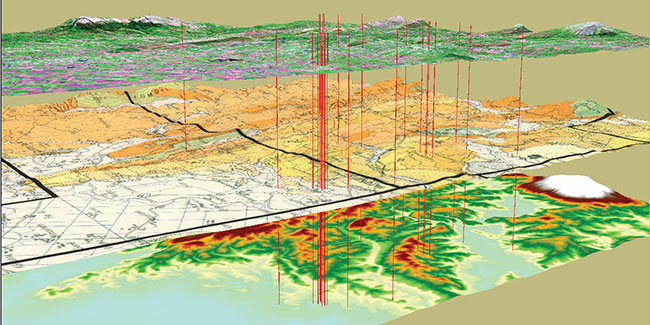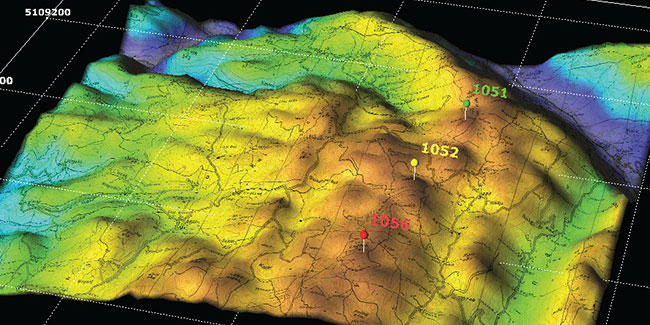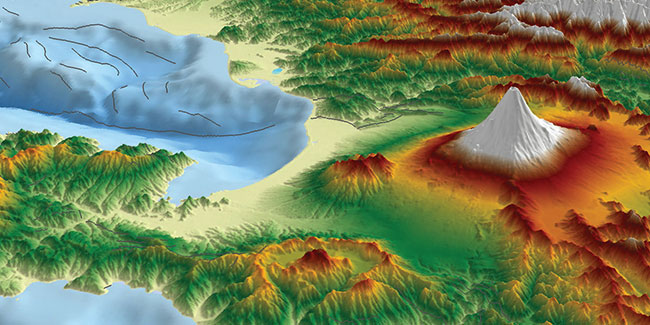GIS Course Descriptions
GEOG 5361. Geographic Information
This course introduces the principles of the structure and function of Geographic Information Systems. This includes raster and vector data structures, coordinate systems, projections and geo-referencing, data capture and editing, creation and management of attribute data, basic and advanced spatial analysis, accuracy and availability of geospatial data, dissemination of output as maps, reports and over the Internet and hardware, software and technology integration issues. Credit 3.
Prerequisite: GEOG 2464.
GEOG 5362. GIS Principles and Applications
Develops hands on skills using industry standard GIS software by putting in practice GIS fundamentals and theories learned in GEOG 5361. GIS application in a wide variety of areas such as local governments, urban infrastructure management, natural resource management, geologic analysis, marketing will be explored. Credit 3.
GEOG 5363. Internet GIS
In this course students will learn the skills needed to share GIS content on the Web or across the enterprise. Students learn to publish maps, imagery, Geoprocessing models and feature templates for use in Web applications that support visualization, analysis and editing of GIS resources. Credit 3.
Prerequisite: GEOG 5362.
GEOG 5364. Spatial Analysis
In this course students will acquire knowledge and techniques of spatial analysis, and learn to effectively use various spatial data to solve real-world problems. Credit 3.
GEOG 5365. Digital Image Processing
This course emphasizes on the general principles of digital image processing to extract information from remotely sensed data. The remotely sensed data to be investigated include Landsat ETM, SPOT, hyperspectral Images and many others. Throughout the course, emphasis would be placed on image processing, image analysis, image classification, and integrating information extracted from remotely sensed data into a GIS. The digital image processing techniques to be covered include: image acquisition, image enhancement, image restoration, color image processing, image segmentation, image compression, image recognition, image quality assessment and statistical evaluation and change detection. Students will learn to use an industry standard digital image processing software- ERDAS Imagine. Credit 3.
GEOG 5366. Cartography and Visualization
This course examines the fundamentals and practical applications of cartographic visualization. The course examines traditional and contemporary cartographic techniques. Topics covered include geospatial data representation, map design, geographic visualization and display. Credit 3.
GEOG 5367. GIS Programming
This course will provide an introduction to computer programming principles and their application in a Geographic Information Systems environment. Principles will be introduced using a GIS scripting language. Once programming principles are understood, students will begin to learn Python programming language for working with ArcGIS software and Python IDLE (Python GUI). Students will master the use of Python scripts to manipulate basic mapping objects and complete geoprocessing tasks. The coursework will involve map scripting, debugging and error handling, and creating custom tools using Python scripts. Credit 3.
Prerequisite: GEOG 5361, Advanced GIS class or Instructor’s consent.
GEOG 5369. Internship in GIS
Students will work in an approved setting to obtain applied experience in the use of GIS. Students must be supervised by a member of the graduate faculty, who will determine whether the nature and amount of the work performed satisfies the requirements for graduate credit. Credit 3.
Prerequisite: GEOG 5361.
GEOG 5371. Energy GIS
This is a survey of use of geographic information systems and related technologies such as GPS and aerial imagery in the energy field, particularly oil and gas production and exploration and midstream and downstream areas. It is useful for graduate students in Applied GIS as well as those professionals in geospatial technologies and earth sciences wishing to learn more about this important application area. It covers such topics as mapping and assessment of basins, plays, fields and wells. Land-base creation and issues, pipeline corridor analysis, and off-shore issues. It also covers integration of CAD data, seismic data, reservoir visualization and aerial imagery. Credit 3.
GEOG 5373. Intro to GPS, LiDAR, & Radar
This course provides the practical skills, knowledge, and understanding of quantitative measurement tools in the field of environmental and geospatial applications. It focuses on the basic concepts and applications of GPS (Global Positioning System), LiDAR (Light Detection and Ranging), and Radar systems. It introduces fundamental concepts of accuracy assessment and appropriate use of these data products. Students will also master the basic skills needed to leverage these data sources and information products in diverse application domains including, topographic mapping, flood inundation studies, vegetation analysis, and 3D modeling of urban infrastructure. Course component includes lectures, labs, and field work. Credit 3.
Prerequisites: GEOG 5361 or Instructor's consent.
GEOG 5374. Advanced GIS Analysis
This is an advanced level GIS analysis course. It teaches students systematically what a typical GIS analysis project should include and be implemented. Topics include defining problem, preparing data, choosing analytical methods, performing statistical analysis, and interpreting and evaluating results. Students will learn how to build and modify geoprocessing models using ArcGIS ModelBuilder and create spatial regression models. Credit 3.
Prerequisites: GEOG 5364 or Instructor’s consent
GEOG 5310. GIS Project Management
This course teaches strategies for successful GIS management and implementation in an institution-wide context. Implementation management strategies are introduced through a process of systematic user needs assessment, requirements specification, database design, application development, implementation, and operation and maintenance. Credit 3.
Prerequisite: GEOG 5361.
GEOG 5311. GIS and Law Enforcement
This is a survey of the use of geographic information systems and related technologies like GPS and aerial imagery in law enforcement. It is intended for graduate students in disciplines such as Applied GIS, Criminal Justice and Digital Forensics. It covers such topics as crime mapping and analysis, policing and deployment, critical incident response, spatial aspects of crime statistics, crime scene investigation, community supervision and corrections, counter terrorism and information security applications areas. Use of tracking devices, laser surveying instruments and drones are featured. Credit 3.
GEOG 5312. GIS ModelBuilder
This course focuses on theories, topics and concepts that provide students a strong understanding of ModelBuilder, a program designed to create automated routines and workflows within a GIS environment. Through the development of skills and techniques with ModelBuilder, students learn how to create, use, and share interactive models within the ArcGIS platform. They will also learn how to document models so others can use them for their own intended purposes. Credit 3.
Prerequisite: GEOG 5362.
GEOG 5075. Special Problems in Geography
This course is designed for graduate students who are capable of independent study of some particular geospatial research topic. Registration is permitted only upon approval of both the departmental faculty member with whom the student will be working and the graduate program coordinator. Students are required to submit a Permission form (See appendix) to enroll in GEOG 5075. Credit 1-3.
GEOG 6261. Seminar in Applied GIS Research Methods
This course provides an introduction to scientific research methods in Geography and Environmental Studies. Topics covered include fundamental research concepts, scientific communication, data collection, physical measurements, behavioral observation and archives, explicit reports (survey, interviews, and tests), experimental and nonexperimental designs, sampling, statistical data analysis, data display, reliability and validity, and ethics in scientific research. This course is required for graduate students taking the thesis option.
GEOG 6398. Thesis I
The student will begin working on a thesis involving research and study of the applications of GIS and related technologies. Prerequisite Consent of graduate supervisor. Credit 3.
GEOG 6399. Thesis II
The student will complete a thesis involving research and study of the applications of GIS and related technologies. The work involved includes research on the approved thesis topic, preparation of a draft and a final thesis. Prerequisite GEOG 6398 or consent of graduate supervisor. Credit 3.




